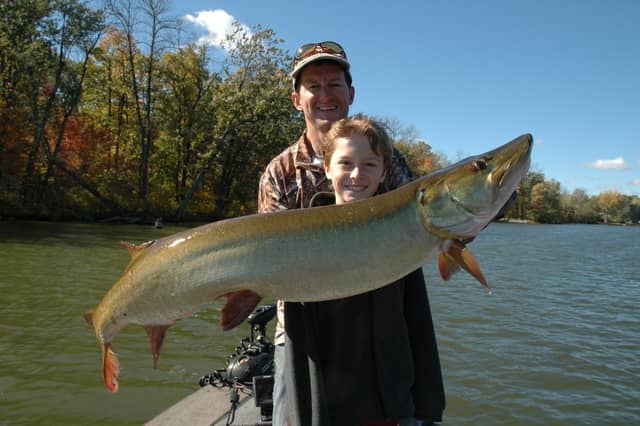Up Your Odds for Michigan Muskie
Dave Mull 06.10.14

With Lake St. Clair and the Detroit River officially opening for muskie fishing last weekend, the season for these freshwater monsters is now in full swing across Michigan. The cold winter and spring have fish in way-early-season patterns, which means your chance at hooking up with the so-called fish of 10,000 casts is pretty good.
“We’re kind of just into early summer mode for these fish with our late spring so it’s all about weed growth,” said Will Schultz of Michigan Muskie Guide Service (616-490-0319). Find growing green weeds and you’ll find the fish that muskies like to eat.
Schultz, of Grand Rapids, not only guides the big, productive lakes of the Antrim Chain in Northern Michigan, he also takes clients to the 150- to 400-acre lakes that have muskie stocks across the southern tier of the state. The smaller lakes he fishes are of two general types: deep, clear lakes suitable for stocking trout, and shallower, weedy lakes, often with slightly stained water. Because of the late spring, the muskies are acting similar in both types of lakes.

“This time of year they actually act more like bass,” Schultz said. “Early and late they’re in the shallow stuff and mid-day they’re deeper on the breaks. If it’s cloudy they’re nearly always shallower, too. [The] best casting lures for shallow fish are a Suick (glide bait) or a bouyant crankbait that you can fish over the tops of the weeds without hanging up.”
Normally, he said, muskies in deep, clear lakes would be suspending off of break lines by now. When that eventually happens, anglers can successfully target them with the Bull Dawg from Musky Innovations or Medussa from Chaos Tackle.
Although guides don’t like to pinpoint specific, smaller inland lakes, mostly because they get flak from friends and companions who fish there when the lake appears in print, the Michigan DNR makes it easy to find good muskie lakes across the state. Just click here to find the better muskie waters in the Michigan counties that have them.
A notable omission on this map are the counties that abut Lake St. Clair and the Detroit River, one of the few areas on the planet where muskies aren’t the mythical fish of 10,000 casts—and not just because anglers usually troll on St. Clair or jig on the Detroit. These two waters are considered a cut above because of their sheer numbers of naturally reproducing Great Lakes strain muskies, which feature spots instead of the vertical bars of their inland cousins.
Spencer Berman of Spencer’s Angling Adventures (419-410-0498) concentrates on both of these waters, trolling or casting in St. Clair and jigging on the Detroit River. He also said that on St. Clair, weeds play a strong role in muskie location now.
“Right out of the gate it’s going to be a lot of shallow water fishing, four- and seven-foot depths,” he shared. “If casting, we’re normally throwing gliders and bucktails,” he continued, noting that the Drifter Hell Hound and six-inch Phantom are proven gliders. He recommended downsizing bucktails, with the Musky Mayhem Jr. Double Cowgirls a top choice.

St. Clair trollers, he said, focus on seven- to 12-foot depths, also downsizing to six-inch baits, with locally made Ziggies and Denato Chubbies in high demand.
Whether casting or trolling St. Clair, Berman recommended moving the lures on the quick side.
“You want to work gliders really fast,” he said. “And trolling, go 3.8 to 4.2 miles per hour.”
While muskies are shallow on St. Clair, they’re deeper on the Detroit River, Berman reported. Here, the tactic is getting over the fish and vertically jigging big artificials such as the Bondy Baits Original or Junior.
“You’re looking for flat stretches of bottom where there’s a consistent depth between 18 and 24 feet at the bottom of the breaklines,” Berman said. “Any kind of a bend with an eddy behind it is a good place to check. Normally the southern end of the river is better than the northern section.”
This article barely scratches the surface of places to catch muskies in Michigan. Other top places include the St. Marys River in the northeast Upper Peninsula, and the U.P.’s Tahquamenon River, also on the eastern end. Muskies also lurk in many other lakes the angler can located via the Michigan DNR website. While muskies will forever be one of the most difficult fish for anglers to catch, armed with good direction to muskie waters and the right lures, Michigan anglers can greatly increase their odds of hooking up.
For more information on Michigan fishing go to michigan.org. Click here to purchase a Michigan fishing license online.
This article was produced in partnership with Pure Michigan.

